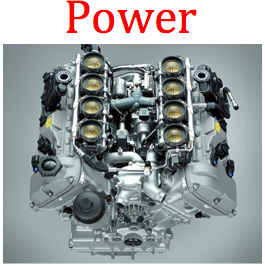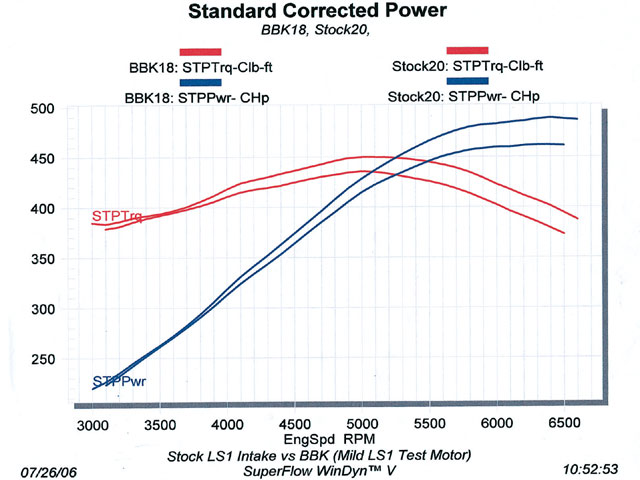| What's Hot! | Products/ Tools | EFI Tuning | Basic Tuning | Advanced Tuning | Chassis Tuning | Advertise with us |
Torque Vs. Horsepower

Understanding the relationship between Horsepower and Torque and how to mathmatically calculate it.
Contributed By: Enginebasics.com
Understand the Basics of Power
Since any of us became interested in engines, we have been interested in power. Power is defined as the amount of work we do in a given time. Or by the equation:
P= Work/Time
So really when we describe something as having a lot of power, we are really saying that it can do a lot of work in a small amount of time. This helps us put perspective on what we are really talking about when we are looking at engine power. In the automotive world we look at two American Standard units we call Torque and Horsepower. What most don’t know is that these two units are intertwined and inseparable. Because of this the goal of a well-powered engine is going to be one with both HP and TQ being very similar to each other. Engines that reliably make both will provide power all the way through the RPM rev range and be very fun to drive.
What is Torque?
The equation for Torque is:
Tq=Force X Lever Arm Distance
So it is the amount of force applied over the length of the lever arm measured from the fulcrum to where you applied the force. In the case of an engine, this would be the force the piston and rod applied on the crank, multiplied by the length of the crank arm. One can then understand why when an engine builder strokes a motor by putting in a longer crank, the motor gains a healthy amount of torque.
What is Horsepower?
Horsepower is a measure of the amount of Work the engine does over a given Time. The basic definition of Work is:
Work = Force x Distance
Therefore: Horsepower = (Force x Distance)/Time
But what we are talking about here is the relationship between Horsepower and Torque. Torque is basically the force that we are talking about in the above equation. So if we substitute that, and clean things up a bit, what we are left with is the following equation:
Horsepower = (Torque X RPM)/5252
John Cooley had the following to say on the matter:
“This actually tells us a lot of interesting things. The first is that at 5252 RPM, an engine’s Horsepower should equal its Torque. I think that you will find that if you look at pretty much any dyno plot of any car, the torque curve and horsepower curve will cross right around 5,200 rpm’s.
The next is that no matter how much torque our engine makes, the amount of horsepower that it produces is directly dependent on how fast the engine is spinning.
Ever wonder how a Honda S2000 can make 230 Horsepower, but less than 200 Ft Lbs. of torque? Well, the early 2.0 Liter S2000’s have a 9,000 rpm redline. If it is spinning that fast, it doesn’t have to produce a lot of torque to make a lot of power. If you plug 230 horsepower and 8,000 rpm’s into the equation above, you should find that you only have to make 150 Ft Lbs. of torque to generate that much power.”
Conclusion
Except in instances of extremes in engine RPM, like with a low revving diesel, or a high revving motorcycle, your goal should be to have as broad of a power band as possible, and therefore a torque and horsepower number as similar to each other as possible. For more information on how to modify your engine to obtain this check the other articles found here on enginebasics.com
ATTENTION READER:
If you enjoyed the information and article you just read be sure to check out our newly released book with even more exciting photo's and information:How to Turbocharge and Tune your Engine

Want to know more about your particular Make and Model vehicle? All of these vehicles are covered in the tech, maintenance and repair articles found above. Enginebasics is the wiki or wikipedia of car part, repair, how to and tuning information. Let us be the class 101 for your automotive learning.
| Ford | General Motors GM | Pontiac | Jaguar | Land Rover | Nissan |
| Toyota | Honda | Lexus | Acura | Lotus | Scion |
| Infinity | BMW | Mercedes | Mitsubishi | Ferrari | Maserati |
| Lamborghini | Volks Wagen VW | Saab | Audi | Hyundai | Kia |
| Subaru | Mazda | Chevy | Volvo | Caddilac | Dodge |
| Chrylser | Daewoo | Porsche | Mercury | Freightliner | MG |
Individual Models
| Ford Mustang | Mitsubishi Eclipse | Mitsubishi Evo | Subaru WRX / STI | Dodge Viper | Chevrolet Corvette |
| Nissan Skyline | Honda S2000 | Nissan 350z | Toyota Supra | Chevy Camaro | Lotus Elise Exige |
| Honda Civic | VW Golf | Dodge SRT-4 | Eagle Talon | Acura Integra | BMW M3 |
| Nissan 240sx | Porsche 911 | Acura NSX | Honda Accord | Toyota Camry | Toyota MR2 |
| VW R32 | Dodge Truck | Mazda Rx7 | VW Jetta | Sand Buggy | Nissan Sentra |
For the latest Automotive news and stories visit the websites below |
Our feature Build: An AWD V6 Civic





